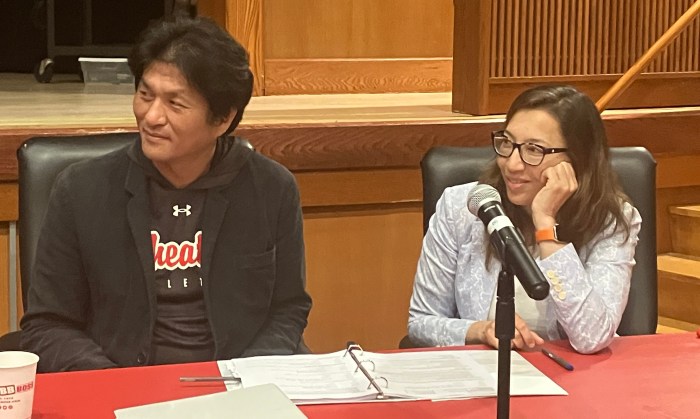Board adopts 2014-2015 school budget
Garden City’s Board of Education adopted a 2014-2015 proposed budget of $109,407,138, to be presented to voters on May 20, under an air of resignation concerning state mandates but an affirmation that the budget has been crafted to best meet the district’s needs.
Superintendent of Schools Dr. Robert Feirsen called this year’s budget review process the most difficult and challenging he’s encountered in the nine years he’s been overseeing the budget. He confirmed that the budget presented was based on feedback from the board and community. He assured that the final budget reflected all discussions, comments, inquiries and last minute changes to state aid.
“The board and the community want the best for our students…on the other hand we find ourselves severely constrained in revenues that we receive from two sources—state aid and taxpayers,” Feirsen said. “We are also limited by the tax levy cap. Our situation did improve somewhat and we made adjustments to the budget.”
The budget reflects an increase of $1,804,772 or 1.68 percent from last year and the projected tax levy increase is 1.57 percent. This is the maximum allowable with a 51 percent majority approval, anything higher than 1.57 would require a 60 percent supermajority.
Feirsen also commented that budget drivers have not changed, noting that pension contributions alone are responsible for about half of the tax increase.
The proposed budget reflects a net reduction of 10.5 full time equivalent (FTE) teaching staff due primarily to enrollment decreases and increased class size to 26; FLES program reduction (program offered to grades four and five only); .5 reduction in high school library staff; administrative, nursing, teacher aide and clerical reductions. Feirsen also advised that there will be two teaching positions, one general and one special education, held in reserve as he cautioned that the budget must cover district needs through 2015.
The nursing reduction, which has caused alarm for parents and the board, has been reconfigured. The current budget calls for 1.3 nurses in each elementary school (reduced from 1.5 staffing), 1 full-time nurse and .3 nurse at each school every day. The .3 is a part-time nurse to help cover during lunch periods and assist with paperwork.
Feirsen advised that there is “no wiggle room…no spare change in the budget and that the additional funds for the nursing change were derived from an anticipated retirement.”
“This is not a picture perfect budget but a responsible and prudent budget that preserves the district’s robust academic program, maintains all programs including FLES and includes security and technology upgrades,” advised Feirsen. “We are a labor intensive entity and the only way to control costs is to control personnel costs.”
If the budget fails, Feirsen warned that the board can develop a revised budget for a second vote; if the second vote fails the district would be required to adopt a contingency (austerity) budget. Under the new tax levy cap law, the district would have a zero percent tax levy cap. This means that the district could not collect any more revenue through property taxes than it collected this year. This would require a reduction of approximately of $1.75 million from the budget. In this scenario, all contractual and debt service obligations; agreements with vendors; and pension obligations remain in effect. Feirsen warned this would have significant impact on school district programs.
Feirsen closed his presentation citing remarks from an editorial piece. He expressed that the state seems to have usurped local control through implementation of Cuomo’s tax cap; reading from the piece, he stated: “Communities no longer get to vote up or down on budgets prepared by their elected representatives on the school board. Instead school boards are forced to come up with budgets that limbo under a tax cap established through a formula so complicated that no one can predict where it will be set…this tax cap measure took away from communities the foundation of democracy—majority rule—when it comes to deciding on their school district’s budget…”
“These are profound words and remind us and the board of the difficult position we are in,” added Feirsen.
Resident queries were minimal, with a resident inquiring whether class size could be reduced in the future. Feirsen replied that the proposed class size is only a guideline and that a reduction is possible in the future.
Resident Sam Myers also voiced concerning regarding class size and questioned whether savings from the district’s energy efficiency contract could be used to keep teachers and class sizes low. Feirsen replied that money can be moved from the capital to program side but capital improvements were necessary to maintain the safety and security of students.
“We had leaky roofs, students wearing rain hats and using umbrellas,” Feirsen said. “We made a choice because buildings were in need of repair and not energy efficient.”
“I’m worried about my kid’s education,” Myers said. “Class size increase is not a good idea.”
Feirsen responded by stating that he does not believe that an addition of one student is significant and the numbers are consistent with the district’s philosophy.
The budget vote will be presented to voters on Tuesday, May 20 from 6 a.m. to 10 p.m. at Garden City High School. A copy of Feirsen’s presentation can be found on the district’s website. Taxes can also be estimated on the school website at http://www.gardencity.k12.ny.us/UserFiles/Servers/Server879883/File/Taxes2013.htm



























